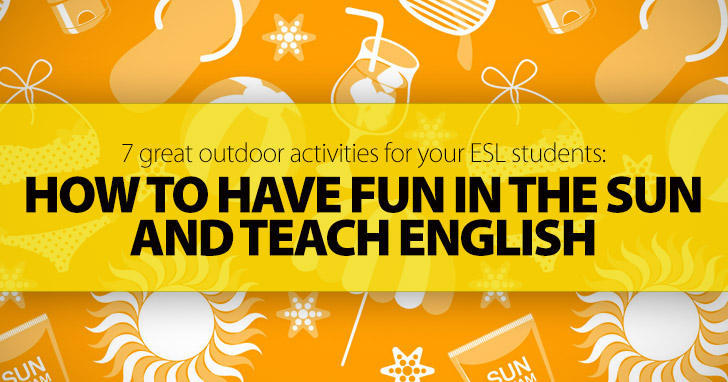7 Great Outdoor Activities for Your ESL Students: How To Have Fun In The Sun And Teach English


The sky is blue. You hear birds outside your window calling you…come outside. Come outside. But you’re the teacher. You can’t just blow off your responsibilities to go and frolic in the green grass and the warm sunshine. Can you? Odds are, if the great outdoors is calling you, it’s calling your students too. But you have a to-do list a semester long and don’t have time to spend a day on play (and the ones paying your salary wouldn’t appreciate it, either). I have good news for you. Going outside is not the classroom taboo you might think it is. In fact, going outside can actually accelerate and enhance your students’ learning. How is that possible? I’m so glad you asked.
When will you have occasion to talk about tree bark, asphalt, or monkey bars inside the classroom? Not as often as you will when you take your class outside. Due to nothing else than a different environment, your students will be exposed to and learn a different set of vocabulary when they are outside. All vocabulary is valuable, so it’s worth it to take your students outside to expand their vocabularies.
The younger your students are, the more important it is for them to base their learning on concrete things - things they can see, hear, smell, taste, and feel. When you take your class outside, they can experience the world around them. Put their hands on trees and rocks and soil. Smell freshly cut grass. Listen to the birds in the trees. When you start with a concrete experience for language instruction rather than an abstract experience, which includes pictures or verbal descriptions, your students will have a firmer foundation on which to base their learning.
Kids like to move, and they need to as well. Keeping kids seated behind a desk all day actually hinders their ability to learn. So when you take your class outside, you give them freedom to move around, to get their bodies involved in learning. And if you have heard of the teaching method Total Physical Response, you already know that when students have their bodies involved in language learning, they learn more easily, more quickly, and they retain more.
My most memorable college class was a freshman English class where we sat on the lawn outside and discussed The Adventures of Huckleberry Finn. It’s not memorable because of the content, much to the chagrin of Mark Twain. I remember that class for the simple reason that we went outside. Getting your students out of their regular locale will spark their memories in a new way, and they will remember what you are teaching more than they would if they were simply in a classroom. So even if you do nothing else “right” outside, just being there will help the information stick.
What is there outside that you don’t get inside the classroom? Fresh air, sunshine, activity, and a decrease in stress. Yes, being outside actually reduces the stress level of your students. And a less stressed student is a better learner.
There is no one right way to take your class outside. There are as many right ways as there are individuals in the classroom. You can keep your outside instruction simple by just sitting on the grass or at picnic tables outside your school and running class as normal. Even if you do nothing else, your students will still reap the benefits of sunshine and fresh air, and your class will be more memorable.
If you give your students free reading time in class, you can also bring them outside to find a comfortable spot in the grass and take in the page under the sun. If you like, bring in a blanket or two and encourage students to have a picnic style reading session out of doors.
I love the idea of doing a reading comprehension activity on the grounds of my school, and students always have a great time. What I do is choose a picture book that has an appropriate amount of text on each page for the level of my class. I make copies of each page and post them in a large loop outside. Students move from one station to another to read the page at that location. At each station I also have a container with a comprehension question about the information on that page. After students read the page, they grab the question and answer it before moving on to the next station. In essence, it’s just reading a book and answering comprehension quotations, but in reality it is so much more. Students love it. At the final station, I may ask students to sequence events, summarize the story, or do some other more comprehensive activity with the book they have just read. And even though we aren’t doing much different than we would do in the classroom, we are having a special learning period outside.
You can tweak just about any classroom activity this way. Just spread it out over a greater distance or have students sit in the grass and any classroom activity becomes an outdoor activity.
One activity I love to do with my students is a nature journal. We go outside for a short walk around our school property, which includes plenty of grassy area and a little bit of woods. I encourage students to make observations as we walk, to note what they see and hear and smell. Then we separate while still outside and spend some time writing about what we saw. Though there is nothing particularly special about the writing assignment, it is always memorable. Sometimes I give my students specific direction on what or how I want them to write. Other times I leave it entirely up to them. After about fifteen to twenty minutes of writing, I bring my class back together to talk about their observations and what they have written. It is fun to see when students observed the same things how excited they get about sharing their observation. And the lesson all comes together because of what they have observed while they were outside.
This is one way of centering your activity around the outdoors. You can do this lots of other ways, too. Just use your surroundings as the starting place for whatever activity you are doing with your students whether it’s sending them on a nature scavenger hunt, observing natural elements that they will later research, or writing about what they see.
I encourage you to try it at least once, and see if your outdoor class isn’t the most memorable class your students experience all year.